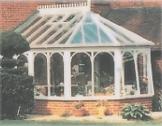Search engine visitors - click here to access entire "$ensible Home" web site
Click here to see a descriptive illustration of a several conservatory designs
Dear Jim: I am planning to add a conservatory to the back of my house for living space (breakfast nook) and plants. Is a conservatory much different than a standard greenhouse? What designs are most efficient? - Andi G.

A: Conservatories are becoming more common today than ever before. In the past, they were used primarily on large, expensive, English-style homes. Many companies that make sunroom kits now also offer conservatories.
The basic difference between a conservatory and a standard sunroom is a conservatory typically has a circular appearance. It often consists of eight or more sides. The roof, usually clear glass or durable plastic, rises to a peak in the center. It may be pitched or have a conical shape.
The original conservatories were made in England. Still today, many of the highest-quality, ornate ones are manufactured in England and shipped to your home for installation. Many manufacturers also send along a technical adviser to help with the basic construction.
The ones built in England are expensive and priced out of reach of most homeowners. The kits produced in the United States are reasonably priced like any other sunroom kit. If you are an avid do-it-yourselfer, you can purchase detailed building plans for about $100 to build a true English-style model.
Other than the styling differences, the main design features to consider in a conservatory are the same as in any sunroom. The framing and glazing (glass or plastic) materials, ventilation systems and shading devices are some of the key features that create efficient, comfortable models.
For the most attractive (and expensive) conservatories, natural wood frames cannot be beat. Using wood, as opposed to aluminum or vinyl extrusions, offers more design and detailing flexibility. Redwood and mahogany are very attractive, but many other types of woods can also be used for the framing.
Some other, lower-cost framing options are low-maintenance aluminum or vinyl-clad wood, metal reinforced vinyl and aluminum. These are very strong, stable materials and are easy to assemble for do-it-yourselfers.
The glass has the greatest impact on efficiency and comfort. For most climates, the minimum quality to use is double-pane, low-e glass. For cold climates, triple-pane or Heat Mirror are good options. For warmer climates, consider tinted glass. Clear double-wall polycarbonate plastic makes a durable roof.
For your breakfast nook, an east or southeast location on your house is ideal for bright sunny breakfasts. For most climates, a true south exposure is best for year-round usage. You must plan for some type of ventilation or shading though or it will probably overheat during summer afternoons.
Instant Download Update Bulletin No. 422 - list of 14 manufacturers of conservatories and a supplier for easy to follow plans to build Victorian conservatory, styles, frame materials, glazing options, features, factors to consider when building a conservatory, recommended conservatory plants and tips, illustrations of typical conservatory designs.
Dear Jim: We run out of water for morning showers. Our incoming water is very cold, so I thought of installing a tankless water heater to preheat the incoming water to the main water heater. Does this sound good? - Mike D.
A: What you are suggesting would probably work, but it is not the best or most energy efficient way to go. If your existing water heater is old, you might just consider replacing it with a new, higher-output model.
If your family members can take their shower consecutively instead of concurrently in several bathrooms, using a tankless water to supply the hot water directly for the bathrooms would be your best and most efficient option.